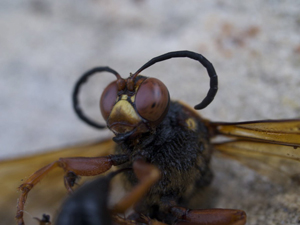CICADA KILLER

I googled up some info from the entomology department at Ohio State University and found the following:
Common Name: Cicada Killer Wasp, Giant Cicada Killer or Sand Hornet
Scientific Name: Sphecius speciosus
Although female Cicada Killer Wasps rarely sting unless disturbed, people may become alarmed or frightened because of their very large size (nearly two inches) and foraging habits in unwanted areas. These solitary wasps may become a nuisance when they dig holes in lawns, sand base volleyball courts, flowerbeds, gardens, and golf course sand traps, kicking out a six to eight inch diameter horseshoe-shaped pile of dirt around the nest entrance. Males have especially aggressive territorial behavior, but have no sting. Females are difficult to provoke, can sting, but rarely do. The female wasps are not aggressive and control is rarely needed except in unwanted places. Adults appear in mid-to-late summer (July and August) causing special concern to individuals with young children.
Identification: The adult cicada killer is a very large (1-1/8 to 1-5/8 inches long), robust wasp with a black body marked with yellow across the thorax (middle part) and on the first three abdominal (rear part) segments. The head and thorax are rusty red and the wings russet yellow (brownish). Legs are yellowish. Coloration may resemble yellow jacket wasps.
Life Cycle and Habits: Solitary wasps (such as a cicada killer) are very different than the social wasps (hornets, yellow jackets and paper wasps). Cicada killer females use their sting to paralyze their prey (cicadas). The female wasps are non-aggressive and rarely sting unless touched, caught in clothing, disturbed by lawn equipment, etc. Though males aggressively defend nesting sites, they have no sting. Adults feed on flower nectar and sap exudates.
These wasps are commonly seen in late summer skimming around the lawn, shrubs and trees searching for cicadas. Cicadas are captured, paralyzed by a sting and used for food to rear their young. After stinging a large cicada, the female wasp drags it up a tree, straddles it and takes off toward the burrow, partly gliding. When trees are not available, the cicada (prey) is dragged to the burrow on the ground. Cicadas are very large insects, sometimes called “locusts.” They sing loudly (noisily) in trees during late summer. Over-wintering occurs as a mature larva within a leathery, brown cocoon in an earthen cell. Pupation occurs in the spring lasting 25 to 30 days. Adult wasps emerge about the first week in July in Ohio. Emergence continues throughout the summer months. Adults live about 60 to 75 days (mid-July to mid-September) while they dig new nesting holes (burrows) in full sun where vegetation is sparse in light, well-drained soils. Eggs are deposited in late July through August. Eggs hatch in one to two days and larvae complete their development in 4 to 14 days. There is only one generation per year.
Burrows & Nests: There may be many individuals flying over a lawn, but each female digs her own burrow six to ten inches deep and one-half inch wide. (They do not nest together.) The soil is dislodged by her mouth, and loose particles are kicked back as a dog would dig. The excess soil thrown out of the burrow forms a U-shaped mound at the entrance, causing unsightly mounds of earth on the turf.
Cicada Killer Wasps may tunnel as much as six inches deep and another six inches horizontally. At the end of the burrow are usually three to four cells where one to two cicadas are placed in each cell with one egg. If all the cells are filled, secondary tunnels are constructed and provisioned. A single burrow may eventually have 10 to 20 cells.
Control Measures: Usually it is not necessary to control cicada killer wasps unless their presence is a nuisance. Sometimes these wasps can be troublesome in high traffic home and commercial areas such as berms around swimming pools, near planters at door entrances, flowerbeds, golf course greens and tees, and other areas. Sometimes they may fly erratically near people, causing fear. Males may actually defend their territory by dive-bombing people’s heads and shoulders!
- What To Know About Mosquito Season - July 19, 2024
- Local Worship & Events: July 19 Update - July 19, 2024
- Allen County Bar Foundation Announces Scholarship Winners - July 19, 2024


